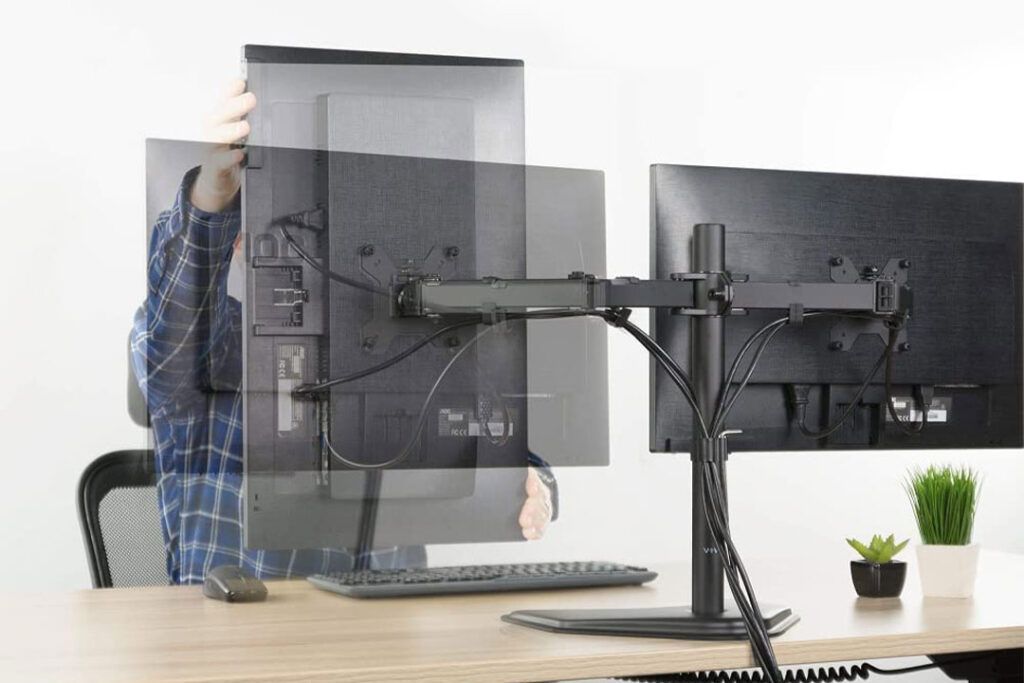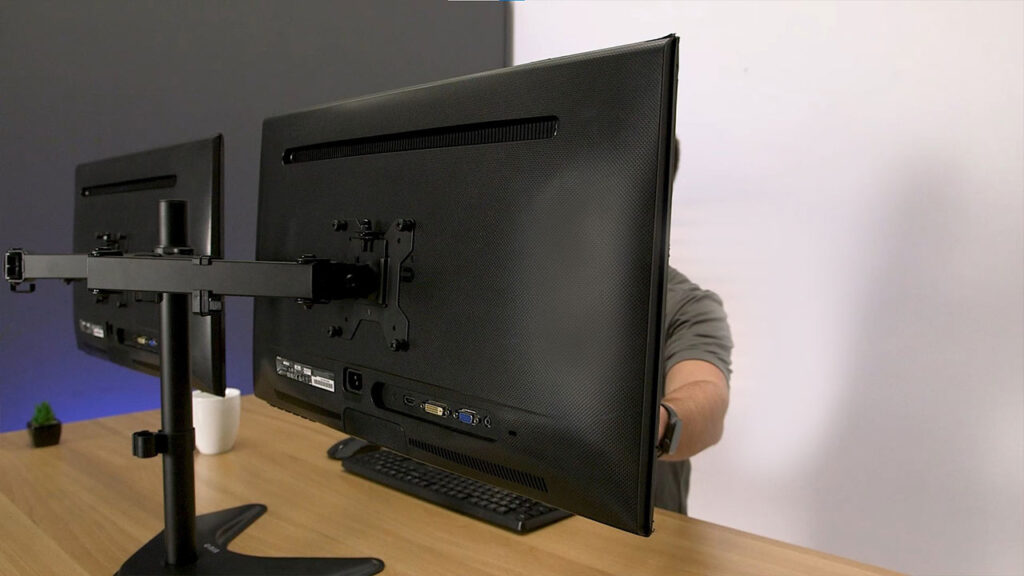Let’s say you are building a new gaming PC. You have decided on what GPU, CPU, motherboard, RAM, cooling system, power supply, etc. you want. However, in most cases, you are likely to spend a big chunk of your time trying to figure out what monitor you should pick. Should you prioritize high resolution like 4K to get the maximum details? Or should you go for a monitor with a high refresh rate like 240Hz to get the best performance? Regardless of what you end up choosing, something that usually gets overlooked when selecting a monitor is the monitor stand! The stand is an essential part of your monitor as it will determine how you will set it up on your desk. But this important component is not usually given much thought.
So, what will happen if you do pick up a random monitor stand? Will it be compatible? Or in other words – Are monitor stands universal?
Yes. Monitor stands are universal as most monitors come with the VESA hole pattern as a standard. The hole patterns are usually 75 x 75 mm or 100 x 100 mm on the back of the monitor, which is compatible with a majority of monitor stands and arms.
However, there are a few exceptions to the rule that we will discuss later. With that said, let’s take a deeper look into the compatibility aspects of a monitor stand so that you can have a better understanding of which one you should go for.

VESA Mounting Standards
The following table shows how the VESA (Video Electronics Standards Association) pattern relates to the screen size of your monitor.
| MIS Standard | Screen Size* | VESA Pattern | Max. Weight* |
|---|---|---|---|
| MIS-D | 12-22.9″ | 75 x 75 mm/100 x 100 mm | 30.8 lb. |
| MIS-E | 23-30.9″ | 200 x 100 mm | 50 lb. |
| MIS-F | 31″ or larger | 200 x 200 mm and above | 250 lb. |
What Is A Monitor Stand?
A monitor stand or a mount is a support arm that holds up a computer monitor or any other kind of display screen. The great thing about monitor stands is that they are very flexible and can be adjusted as per your need. Some are quite basic which lets you only adjust the height of your monitor, while others let you change the viewing angle. However, some of the most feature-packed stands come with a hefty price tag.
What Does A Monitor Stand Do?
The purpose of a monitor stand is to hold your computer screen in place. It also serves as a component to help you adjust your monitor by moving it up or down, rotating it, tilting it, angling it, etc. A proper monitor stand will help you to place your screen in an optimal position so that you don’t suffer from excessive eye strain, fatigue, neck pain, or back pain.

What Is The Standard VESA Hole Pattern?
The Video Electronics Standards Association, or VESA for short, is an organization that defined the standard for wall mounts and stands used for PC monitors, TVs, and other forms of flat panel displays. This standard is followed by most display manufacturers so that their monitors are compatible with all kinds of stands and mounts. And the dimensions of this pattern measure 75 x 75 mm or 100 x 100 mm holes at the back of your monitor.
How To Tell If Your Monitor Has A VESA Mount?
You can tell if your monitor has the VESA hole pattern by looking at the back of it. You’ll be able to see four circular holes which you can use to install your stand or mount. In some cases, you may need to remove the back panel of your monitor to get access to the hole pattern. But if you are still confused about how to locate the mounting plate of your monitor, then you should refer to your monitor’s user manual.
How To Install A Desktop Monitor Stand?
Installing a monitor stand can be a quick and easy process, but it’s important to take your time and follow the manufacturer’s instructions to ensure that your monitor is securely attached and adjusted to the correct height and angle. Keep in mind that depending on the type of monitor stand you use, the installation process can vary. Refer to the manufacturer’s guide on how to install your monitor stand. Here is a basic outline of what you need to do:
Step 1- Unpack the Stand and Components
The first step in installing a monitor stand is to unpack it and all of its components. This will typically include the stand base, the monitor mount, and any hardware that is needed to attach the mount to the base. Carefully remove all of the components from the packaging and lay them out.
Step 2 – Place the Stand Base
Take the stand base and place it on a flat surface, such as a desk or table. Make sure the surface is clean and free of any debris or obstacles that could interfere with the installation process.
Step 3 – Attach the Monitor Mount
Securely attach the monitor mount to the stand base using the provided hardware and any necessary tools. Keep a Phillips head screwdriver nearby as it can come in handy when installing monitor stands. The installation process will typically involve aligning the mount with the base and securing it in place with screws or bolts. Be sure to follow the manufacturer’s instructions for this step, as different stands may have different mounting methods.
Step 4 – Carefully Lift the Monitor
Take the monitor and carefully place it onto the mount, making sure it is securely attached before letting it go. It’s important to exercise caution when handling the monitor, as it can be heavy and fragile.
Step 5 – Adjust the Monitor
Adjust the monitor to your desired height and angle. Most monitor stands will allow you to adjust your monitor to suit your preferences. This can be done by loosening or tightening the adjustment knobs or bolts on the stand. However, the capabilities of your stand will come down to which brand and model you are going for.
Step 6 – Tighten Any Screws or Bolts
Once the monitor is in your desired position, tighten any screws or bolts to hold the monitor securely in place. This will ensure that the monitor stays in your desired position and won’t shift or move while you’re using it.
Types of Monitor Stands
There are several types of monitor stands available in the market. To give you an idea, here are the most popular kinds of monitor stands that you can consider getting.

Desktop Stands
These are the most common type of monitor stand, and they sit on a desk or table. Desktop stands come in a variety of sizes, shapes, and materials, and they are designed to raise the monitor to eye level, reducing neck and eye strain. They also allow for greater adjustability in the tilt and angle of the monitor, making it easier to find a comfortable viewing position.
Wall-Mounted Stands
These stands allow the monitor to be mounted to a wall, freeing up desk space. Wall-mounted stands are a great option for those with limited desk space, and they allow for easy adjustment of the monitor’s height and angle. They also provide a more secure and stable mount for the monitor, reducing the risk of accidents or damage.
Arm-Mounted Stands
These stands use an adjustable arm to hold the monitor, allowing for greater flexibility in positioning. Arm-mounted stands to allow for easy movement of the monitor, making it simple to share the screen with others or to adjust the angle for better viewing. They also provide a clean, clutter-free look to your desk setup.
Floor Stands
These stands hold the monitor on a tall pole, allowing it to be viewed from a standing position. Floor stands are ideal for those who spend a lot of time standing at their desks, as they allow for a more ergonomic viewing position. They also provide a sleek and professional look to your setup.
Mounting Brackets
This type of stand allows the monitor to be mounted on the back of a desk or a wall. This is a great option for those who want to conserve desk space and create a clean and minimalistic look to their setup.
Multi-Monitor Stands
This type of stand can hold multiple monitors, which is useful for gaming and video editing. Multi-monitor stands allow you to have multiple screens and work or play with multiple windows open at the same time, providing an ergonomic and efficient way to increase productivity and gaming experience.
Are Dual Monitor Stands Universal?
Yes, dual monitor stands are also universal. As mentioned previously, if both your monitors have a VESA hole pattern, then you can mount them both on a dual monitor stand. But if the monitor or the stand is proprietary, then they won’t be universal as they are designed to work with products of a particular brand. However, certain companies also provide attachment brackets that come with the VESA hole pattern so that you can use any dual monitor stand. Since it is the standard for all monitor stands, you are more than likely to find a solution even if your monitor does not directly come with the VESA hole pattern.

Can You Switch Monitor Mounts?
Yes, you can switch monitor mounts as long as they are using the VESA standard mounting style. However, if your monitor has a larger hole pattern than the VESA standard (75 x 75 mm or 100 x 100 mm), like 200 x 100 mm, 200 x 200 mm, 400 x 400 mm, or 800 x 800 mm, then you will need to attach an additional bracket before you can use your monitor mount.
What If Your Monitor Does Not Have Any Mounting Holes In The Back?
If your monitor does not have a VESA hole pattern in the back, then you will need to purchase a monitor adapter mount kit and attach it to the back. You will then be able to use a monitor stand or mount as per your preference.
How To Choose A Monitor Stand?
Before going out and getting yourself a monitor, consider these factors.
Size
Measure the dimensions and weight of your monitor to make sure that the stand you choose is the right size. Also, consider the space you have available on your desk and choose a stand that will fit accordingly.
Adjustability
A monitor stand can help improve your posture and reduce eye strain. Look for a stand that allows you to adjust the height of your monitor to eye level, and also tilts and swivels to reduce glare and improve viewing angles.
Compatibility
Check the back of your monitor to ensure that it has a VESA hole pattern before deciding on which monitor stand you want to buy. If you do not have a standard VESA pattern, then you will need to get an additional attachment bracket.
Style
Monitor stands come in a variety of styles, from sleek and modern to traditional and classic. Choose a stand that complements the aesthetic of your space.

Are Monitor Stands Universal? Key Takeaway
“The key takeaway from this article is that – Yes, monitor stands are universal for the most part. While there are several different types of monitor stands available in the market, most of them will be compatible with your monitor. Although there are some exceptions to the rule, your monitor stand of choice will still be compatible as long as you get the right attachment bracket.”







